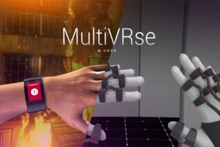UNSN
MultiVRse: Parallel Physical and VR Universes
3rd place - $8,000 Prize
Auto VR visualization matching the physical space, untethered & unbounded VR, interaction with real & VR objects, no cameras needed + more!

About the Team
Team Members: MultiVRse - parallel physical and VR universes
UNSN (/unseen/) is a creative-tech innovation collective. They focus on pushing the boundaries of UX by introducing brave and unconventional ways of interacting with the physical and digital world around you, designing true experiences of the future.
UNSN co-founders come from a creative-tech background. They have years-long experience as Technical and Art Directors respectively in world’s top innovation studios delivering groundbreaking AR / VR, web, mobile and physical content to brands. They have technically and artistically led projects for clients like Disney, Google, 20th Century Fox, Nissan or Reebok, scoring over 70 awards including Emmy, Cannes Lions, SxSW, Adobe Cutting Edge Award, Webby and CLIO.
The Solution
UNSN’s MultiVRse proposal used modular design to construct a map in the virtual space. This allows for custom virtual environments and passive haptic feedback with low-fidelity real world objects. Floor tiles would be equipped with an Arduino-based NFC reader that could locate objects placed on the tiles. The physical environment would be modular and quick to assemble, and would automatically generate matching VR environments. This was done via physical blocks with NFC tags, which were placed upon floor tiles with NFC tags. The system would know which block was placed on which tile and automatically generate the corresponding VR environment, suggesting the ability to add additional building floors. The MultiVRse proposal focused on user flexibility, designing for the least restrictions possible. The user would be completely untethered and unbounded, capable of interacting with other untethered users with full visualization of their own body, without cameras, in the virtual space. The user also had the ability to switch to an augmented reality mode. Full body visualization would be accomplished with an existing third-party product, Perception Neuron. This technology, developed for VR, creates a model of the user’s body in the virtual environment in real time using sensors directly placed on the user. The BRIDGE VR headset, used in tandem with the Perception Neuron, would allow the user hands-free interaction and the ability to save each performance/run as a replay-able ghost. Textures would be rendered onto the model within the virtual environment, allowing the user to see their own limbs, hands, and movement.

